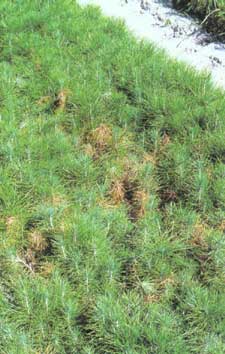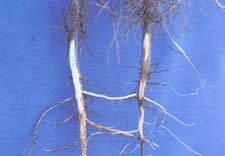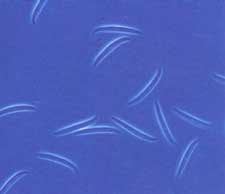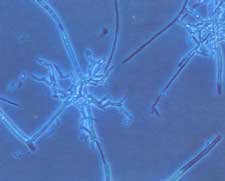Pitch Canker of Southern PineGeorge M. Blakeslee - Associate Professor of Forest Pathology, School of Forest Resources and Conservation, University of Florida, Gainesville, FL, Cordell C.E., Anderson R.L., Hoffard W.H., Landis T.D., Smith R.S. Jr., Toko H.V., 1989. Forest Nursery Pests. USDA Forest Service, Agriculture Handbook No. 680, 184 pp. Hosts Pitch canker, caused by the fungus Fusarium subglutinans (syn. F. moniliforme var. subglutinans), has been reported on older trees of at least 10 pine species. However, slash and loblolly pines are the only known seedling hosts, and slash pine the principal species affected. Distribution This disease was first detected in slash pine nurseries in Florida. It is now known to occur in pine nurseries throughout the South. Damage This disease has been recognized only recently in nurseries but may cause significant seedling mortality. Mortality of nursery-infected seedlings following outplanting may result in additional losses.
The fungus can be cultured from infected tissues on acidified potato-dextrose agar. The pathogen is characterized microscopically by curved, multiseptate macroconidia, 32-53 x 3-4.5 microns (Fig. 18-3) and abundant oval to oblong microconidia, 8-12 x 2-3 microns, produced on polyphialides (Fig. 18-4); chlamydospores are absent Biology The fungus probably enters a nursery either as airborne inoculum from nearby infected trees or, more commonly, on infected seed. Once a nursery becomes infested, further spread of the disease during the growing season probably results from inoculum produced on previously infected seedlings. Control Prevention -- Use disease-free seed to prevent the fungus from being introduced into the nursery. Screen the seed to identify fungal contamination. Employ proper cone- and seed-handling procedures to minimize contamination of seed. Cultural -- Remove pitch canker infected trees in windbreaks, in border plantings, or in adjacent stands, thereby reducing nearby sources of inoculum. Partial sanitation of nursery beds during the growing season may be achieved by removing infected seedlings. During lifting and packing, cull symptomatic seedlings to reduce disperal of the fungus to outplantings and to minimize exposure of healthy seedlings to diseased ones. Chemical -- Fumigation with standard formulations and dosage rates of methyl bromide-chloropicrin is effective in eradicating the pathogen from the soil. No fungicides are currently available to treat seeds or seedlings. Selected References Barnard, E. L.; Blakeslee, G. M. 1980. Pitch canker of slash pine seedlings: a new disease in forest tree nurseries. Plant Disease. 64: 695-696. Blakeslee, G. M.; Dwinell, L. D.; Anderson, R. L. 1980. Pitch canker of southern pines: identification and management considerations. For. Rep. SA-FR11. Atlanta,GA: U.S. Department of Agriculture, Forest Service, Southern Area, State and Private Forestry. 15 p. Miller, T.; Bramlett, D. L. 1979: Damage to reproductive structures of slash pine by two seed-borne pathogens: Diplodia gossypina and Fusarium moniliforme var. subglutinans. In: Bonner, F., ed. Symposium on flowering and seed development in trees: proceedings of the symposium: 1978 May 15-18; Starkville, MS. [Place of publication unknown]: U.S. Government Printing Office: 347-355 |
Forest Pests: Insects, Diseases & Other Damage Agents |

|
|





